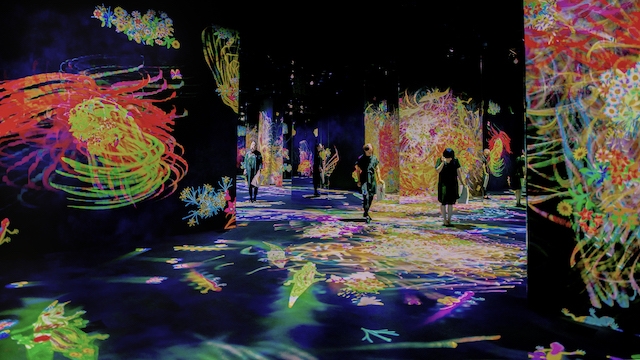Amos Rex, Helsinki’s recently inaugurated private museum of new media art, opens with Massless. The institution, formerly called the Amos Anderson Museum and housed from 1965 to 2017 less than a kilometre away from its new site, opens with five interactive works by teamLab, a Tokyo-based interdisciplinary art collective boasting 500 members. Comprising computer programmers, artists, animators, architects, graphic designers and writers, the group resembles a videogame production company more than an artists’ cooperative. Indeed, the sense of audience immersion in their audiovisual works might best be described in terms of a kind of ‘affect’: a term deriving from media theory that describes the sensation of being immersed within a digital space. At Amos Rex, the results both complement and contend with a cavernous subterranean space excavated beneath Helsinki’s 1930s Lasiplatsi building, a sleek functionalist former office complex containing a still-operating film theatre and several restaurants.
Descending a staircase into the basement, the visitor first enters one of three purpose-made, largescale, black-box installation rooms adjacent to the museum’s collection of Post-Impressionist art, and finds themselves in front of Black Waves (2016): a projection of a rough sea on a concave wall, hauntingly soundtracked by Hideaki Takahashi. The sea appears at points to almost spray outwards as it ebbs and flows, seemingly both real and idealised. The animation is based on the movement of actual water, the pixels charting its flow overlaid with lines that resemble those in premodern Japanese printmaking (Hiroshige, Hokusai). The result is a sea as if drawn from the collective imagination, more real perhaps than one simply captured on DV camera or iPhone.
Next comes Graffiti Nature: Lost, Immersed and Reborn (2018), a kind of psychedelic garden replete with multicoloured fauna, lizards, frogs, birds, butterflies and even a large whale, covering floor, walls and ceiling in constant creaturely movement. Mirrored surfaces give the space an endless dimension, and extending the work further, in a number of connected ‘drawing rooms’ visitors are invited to colour in templates of the featured animals on paper, scanned by an assistant to appear in the installation proper within moments. This interactive experience places the user at the centre of an ecosystem where animals are eaten by predators, which then multiply. Animals that don’t eat for a while become extinct. Such an environment ports pet- and agricultural simulator games like Stardew Valley (2016) into virtuality, the visitor parachuted into a computer-generated natural world for which they are in part responsible.
Amos Rex’s main exhibition room, in turn, contains the site-specific digital installation Vortex of Light Particles (2018), the domed ceiling leading to a circular skylight that, blacked out, acts as a kind of vortex drawing in computerised light particles. Evoking water running down a huge planetary drain seen from upside-down, the works engender awe. The individual human is secondary to nature, albeit a nature created digitally. Aside from a corridor-sited video loop, Enso (2017), based on a spatial rendering of traditional Japanese calligraphy, there is one last major installation, Crows are chased and the Chasing Crows are Destined to be Chased as well, Transcending Space (2017). Referring to the cyclical tendencies of nature, this surrounds the viewer with erratically moving three-legged crows, a symbol from Eastern mythology representing the sun. Leaving traces of light, they scatter upon impact with one another, turning into flowers. The effect of the darting crows and the weave of lights behind them delivers an intense feeling of being at the centre of a furious, beautiful battle, a mesmerising cataclysm. Together with the other works that make up Massless,Crows… uses digital technology to revisit pre- and early modern explorations of sublime nature. Together, the works here point to a possible future for art, one that looks both pretty and awe-inspiring.
teamLab: Massless at Amos Rex, Helsinki, 30 August – 6 January
From the December 2018 issue of ArtReview
